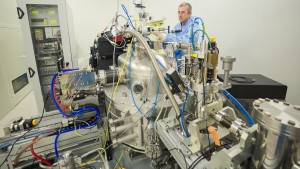Scientists from the University of Warwick have uncovered a revolutionary organic metal that is able to identify and kill cancer cells.
The research took place at the European Synchrotron Radiation Facility (ESRF) in Grenoble, alongside Dr Peter Cloetens.
Their research has shown that the organo-metal FY26 is 50 times more powerful than the commonly used cancer drug Cisplatin. It is believed that the osmium-based compound is able to specifically target and remove the energy-generating component of the cancer.
At the French facility, researchers were able to use high powered X-ray beams to see how real life doses of the compound would attack the affected cells.
The groundbreaking discovery should be applicable in a wide variety of cancers.
Regarding ovarian cancer cells, scientists were able to observe FY26 position itself within the actual cell to in order to destroy its vital functions.
T he compound is considered to be more efficient in fighting the specifically diseased cells, as it is evident that FY26 has a stronger ability to differentiate between normal cells and cancer cells than that of Cisplatin.
he compound is considered to be more efficient in fighting the specifically diseased cells, as it is evident that FY26 has a stronger ability to differentiate between normal cells and cancer cells than that of Cisplatin.
The current treatments for chemotherapy utilises platinum compounds, a practise that was introduced over 40 years ago.
It is hoped that this recent discovery of organo-metal will help initiate the introduction of new drugs to tackle the disease.
University of Warwick professor, Peter Sadler said: “Cancer drugs with new mechanisms of actions which can combat resistance and have fewer side-effects are urgently needed.”
He further added “The advanced nano-focussed X-ray beam at ESRF has not only allowed us to locate the site of action of our novel Organo-Osmium FY26 candidate drug in cancer cells at unprecedented resolution, but also study the movement of natural metals such as zinc and calcium in cells.”
Dr Cloetens added: “These kinds of experiments are normally performed using bigger doses than what would be done in real life or on a coarse scale that does not provide a clear picture of the processes that take place.
“On the new nano-imaging ID16A beamline, however, by combining a very tight focus and high flux, we could get a real picture of where the drug goes in a single cell using real-life pharmacological doses.”























